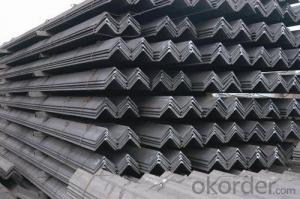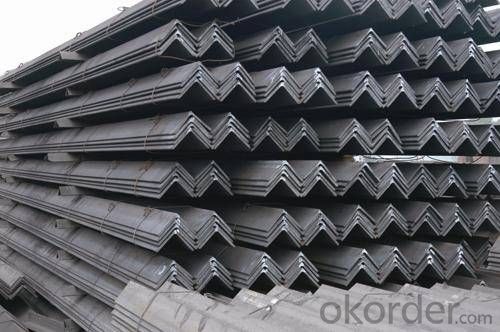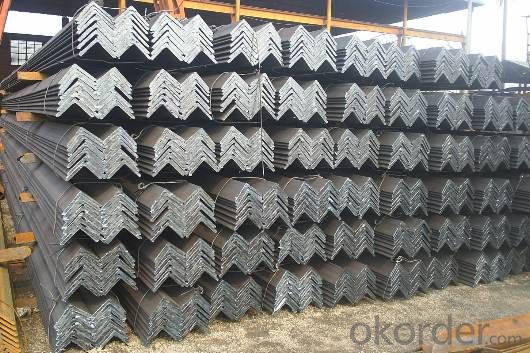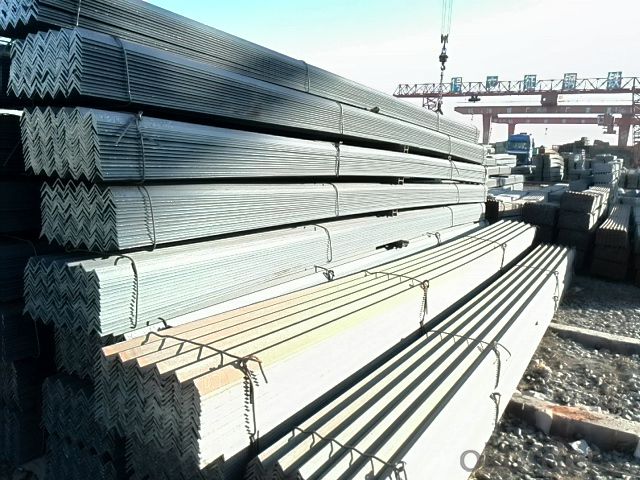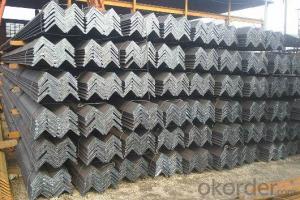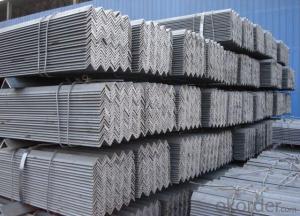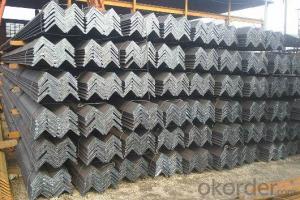Hot Rolled Steel Angle Bars with Lowest Price
- Loading Port:
- Tianjin
- Payment Terms:
- TT OR LC
- Min Order Qty:
- 25 m.t
- Supply Capability:
- 10000 m.t/month
OKorder Service Pledge
OKorder Financial Service
You Might Also Like
Specification
Okorder.com is a professional materials & equipment supplier & manufacturer, offers integrated one-stop services including real-time quoting and online cargo tracking. We are funded by CNBM Group, a Fortune 500 enterprise and the largest materials & equipment firm in China.
Product Applications:
According to the needs of different structures, Angle can compose to different force support component, and also can be the connections between components. It is widely used in various building structures and engineering structures such as roof beams, bridges, transmission towers, hoisting machinery and transport machinery, ships, industrial furnaces, reaction tower, container frame and warehouse etc.
Product Advantages:
OKorder's Steel Angles are durable, strong, and resist corrosion.
Main Product Features:
· Premium quality
· Prompt delivery & seaworthy packing (30-45 days after receiving deposit)
· Corrosion resistance
· Can be recycled and reused
· Mill test certification
· Professional Service
· Competitive pricing
Product Specifications:
1. Invoicing on theoretical weight or actual weight as customer request
2. Length: 6m, 9m, 12m as following table
3. Sizes

Sizes: 25mm-250mm | ||
a*t | ||
25*2.5-4.0 | 70*6.0-9.0 | 130*9.0-15 |
30*2.5-6.6 | 75*6.0-9.0 | 140*10-14 |
36*3.0-5.0 | 80*5.0-10 | 150*10-20 |
38*2.3-6.0 | 90*7.0-10 | 160*10-16 |
40*3.0-5.0 | 100*6.0-12 | 175*12-15 |
45*4.0-6.0 | 110*8.0-10 | 180*12-18 |
50*4.0-6.0 | 120*6.0-15 | 200*14-25 |
60*4.0-8.0 | 125*8.0-14 | 250*25 |
FAQ:
Q1: Why buy Materials & Equipment from OKorder.com?
A1: All products are carefully selected from China's most reliable manufacturing enterprises. Through its ISO certifications, OKorder.com adheres to the highest standards and a commitment to supply chain safety and customer satisfaction. We can guarantee the quality!
Q2: The products are invoicing on theoretical weight or on actual weight?
A2: We can do it in both manners, it’s according to buyer's requirement.
Q3: Can you offer the third part inspection certificates ?
A3: Yes, we can apply third part inspection before shipping, such as SGS, BV, etc .
Images:
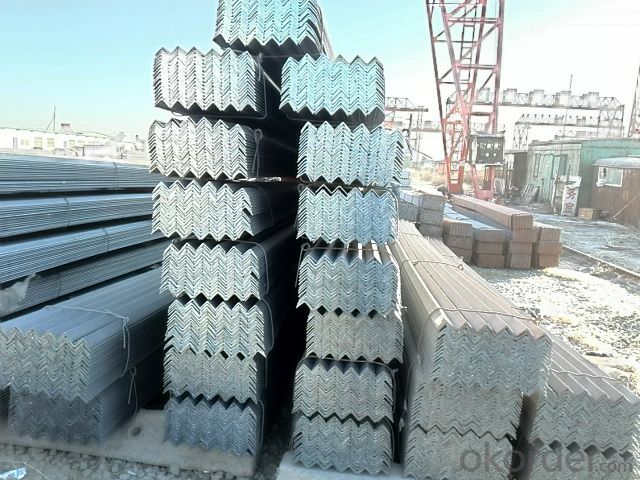
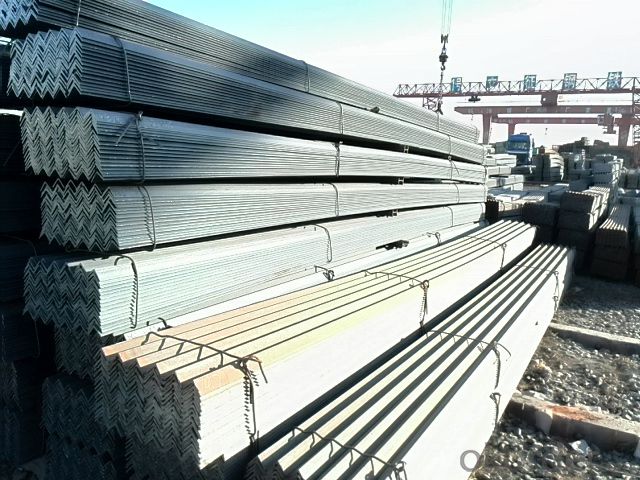
- Q: Can steel angles be used in outdoor or exposed environments?
- Yes, steel angles can be used in outdoor or exposed environments. Steel angles are commonly used in construction and engineering projects and are known for their durability and strength. They are often galvanized or coated with protective finishes to prevent rust and corrosion, making them suitable for outdoor use. Additionally, steel angles can withstand various weather conditions, making them a reliable choice for outdoor or exposed environments.
- Q: How do steel angles compare to aluminum angles?
- Steel angles and aluminum angles have different properties and characteristics, making them suitable for different applications. Steel angles, also known as steel L-shaped beams, are known for their strength and durability. They are often used in construction projects, such as building frames, bridges, and industrial structures, where their high load-bearing capacity is crucial. Steel angles have a higher tensile strength compared to aluminum angles, which means they can withstand greater forces without deforming or breaking. On the other hand, aluminum angles are lightweight and have excellent corrosion resistance. This makes them ideal for applications where weight is a concern, such as aerospace and marine industries. Aluminum angles are also commonly used in architectural projects, as they can be easily shaped and formed into various designs. Additionally, aluminum angles have good thermal and electrical conductivity properties, making them suitable for heat transfer applications. In terms of cost, steel angles are generally more affordable than aluminum angles due to the lower cost of steel production. However, aluminum angles often require less maintenance and have a longer lifespan due to their resistance to corrosion. Ultimately, the choice between steel angles and aluminum angles depends on the specific requirements of the project. If high strength and durability are needed, steel angles are preferable. If weight, corrosion resistance, and design flexibility are more important, aluminum angles are the better choice.
- Q: What are the standard dimensions for equal leg steel angles?
- The standard dimensions for equal leg steel angles vary depending on the industry and country. However, in general, the standard dimensions for equal leg steel angles are typically measured in terms of the length of each leg and the thickness of the angle. Common dimensions include leg lengths ranging from 20mm to 200mm, with thicknesses ranging from 3mm to 20mm. These dimensions are often specified in millimeters and can be further customized to meet specific project requirements. It is important to consult industry standards and specifications to determine the exact dimensions for equal leg steel angles in a particular context.
- Q: Can steel angles be used for support structures in stadiums or arenas?
- Certainly! Support structures in stadiums or arenas can utilize steel angles. Due to their strength, durability, and versatility, steel angles are commonly employed in construction and engineering projects. They are frequently employed in structural applications that necessitate load-bearing support, rendering them suitable for supporting the weight of stadium or arena structures. Steel angles can serve as beams, columns, or trusses, delivering the requisite support and stability for sizable structures. Their capacity to withstand substantial loads and resist bending or warping makes them a favored option for constructing stadium roofs, grandstands, and other support systems. Furthermore, steel angles can be easily fabricated and tailored to meet specific design requirements, enabling efficient and cost-effective construction of stadium and arena support structures.
- Q: Can steel angles be used for reinforcement in concrete structures?
- Yes, steel angles can be used for reinforcement in concrete structures. Steel angles, also known as L-shaped steel profiles, are commonly used as reinforcing bars in concrete construction. They provide increased strength and stability to the concrete structure, especially in areas where additional support is needed. Steel angles are typically placed within the concrete forms, ensuring proper alignment and spacing, and then embedded in the concrete during the pouring process. This reinforcement helps to prevent cracking and enhance the overall structural integrity of the concrete structure. Steel angles are versatile and can be used in various concrete applications, such as beams, columns, walls, and slabs.
- Q: Do steel angles come with any warranties?
- Indeed, warranties are usually included with steel angles. The particular terms of the warranty may differ contingent upon the manufacturer or supplier. Nevertheless, reputable companies commonly provide warranties to guarantee the excellence and functionality of their steel angles. These warranties generally encompass flaws in materials or workmanship and can span from a few months to numerous years. It is prudent to review the manufacturer or supplier's warranty terms and conditions prior to acquiring steel angles to comprehend the scope and duration of the warranty coverage.
- Q: Are there any limitations on the angle of inclination for steel angles?
- There exist restrictions on the angle of inclination for steel angles. The angle of inclination pertains to how the steel angle is positioned or installed in a structure. The limitations regarding this angle are influenced by several factors, including the type and thickness of the steel angle, the load it is anticipated to bear, and the precise design and engineering requirements of the structure. Typically, steel angles can be installed at a variety of angles of inclination, ranging from vertical (90 degrees) to horizontal (0 degrees). However, it is crucial to consider practical restrictions. Steel angles are typically engineered to bear loads in a specific direction, and straying too far from the intended angle of inclination can compromise their structural integrity and load-bearing capacity. Furthermore, the installation angle of steel angles may be restricted by the connection methods employed. Welding, bolting, or other fastening techniques may have specific prerequisites for the angle of inclination to ensure proper connection strength and stability. To ascertain the specific limitations on the angle of inclination for steel angles in a particular application, it is important to consult relevant building codes, standards, and engineering guidelines. Professional structural engineers possess the necessary expertise and guidance to ensure that the steel angles are installed within safe and appropriate limits.
- Q: What are the standard sizes for steel angles?
- The standard sizes for steel angles vary depending on the country and industry standards. In general, steel angles are available in a range of sizes to accommodate different applications and structural requirements. Common sizes include equal angles, which have equal sides, and unequal angles, which have different lengths on each side. Some commonly used standard sizes for steel angles include 25x25mm, 30x30mm, 40x40mm, 50x50mm, 65x65mm, 75x75mm, 100x100mm, 150x150mm, and 200x200mm. However, it is important to note that these sizes may vary and can be customized based on specific project requirements and regional standards.
- Q: How do steel angles perform in earthquake-prone regions?
- Steel angles perform well in earthquake-prone regions due to their high strength and flexibility. They are commonly used in structural systems to resist lateral forces and provide stability during seismic events. The angular shape of the steel angles helps in distributing the seismic forces effectively, reducing the risk of structural failure. Additionally, steel's ductility allows it to bend without fracturing, further enhancing its performance in earthquake-prone areas.
- Q: What are the different types of steel angle connections used in seismic design?
- Seismic design incorporates various types of steel angle connections that are commonly utilized. These connections are specifically engineered to withstand the forces and movements experienced during seismic events. Several types of steel angle connections used in seismic design are as follows: 1. Bolted Flange Plate Connection: This connection involves the bolting of a steel plate to the flanges of two angle sections. It demonstrates excellent resistance against lateral and vertical forces while accommodating rotational movements. 2. Welded Flange Plate Connection: Similar to the bolted flange plate connection, this connection entails the welding of a steel plate to the flanges of two angle sections. It offers superior strength and stiffness but is less ductile when compared to the bolted version. 3. Extended Single Plate Connection: This connection is established by extending a single plate beyond the flanges of two angle sections and welding it to both flanges. It provides commendable resistance against lateral and vertical forces while accommodating some degree of rotation. 4. Double Angle Connection: In this connection, two angle sections are joined together using bolts or welds. It possesses high strength and stiffness, effectively resisting lateral and vertical forces. 5. Diagonal Brace Connection: This connection involves connecting diagonal braces to the flanges of two angle sections. It enhances resistance against lateral forces and effectively controls building sway during seismic events. 6. Gusset Plate Connection: This connection employs a gusset plate to connect two or more angle sections. It demonstrates good strength and stiffness while effectively resisting lateral and vertical forces. Each of these steel angle connections possesses its own advantages and disadvantages. The choice of connection relies on factors such as structural design requirements, loadings, and the level of seismic activity in the region. It is crucial to carefully consider these factors and seek consultation with structural engineers to ensure the appropriate connection type is employed for a seismic design project.
Send your message to us
Hot Rolled Steel Angle Bars with Lowest Price
- Loading Port:
- Tianjin
- Payment Terms:
- TT OR LC
- Min Order Qty:
- 25 m.t
- Supply Capability:
- 10000 m.t/month
OKorder Service Pledge
OKorder Financial Service
Similar products
Hot products
Hot Searches
Related keywords
